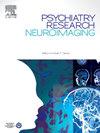The relationship between α4β2-nicotinic acetylcholine receptor availability and brain arousal regulation as assessed by 2-[18F]F-A85380 PET and EEG following nicotine cessation in male individuals with nicotine dependence
IF 2.1
4区 医学
Q3 CLINICAL NEUROLOGY
引用次数: 0
Abstract
Background
While α4β2-nicotinic-acetylcholine-receptor (α4β2-nAChR) density has been linked to cognitive performance, it remains unclear whether nicotine’s cognitive-enhancing effect are mediated primarily through direct receptor action. An alternative view suggests that nicotine exerts its influence by stabilizing brain arousal, which can be assessed using electroencephalography (EEG). This study examines the relationship between changes in α4β2-nAChR availability and brain arousal regulation following nicotine cessation in nicotine-dependent males.
Methods
Ten nicotine-dependent male participants underwent assessments during continued smoking, 24-h, and 7-day nicotine cessation in counterbalanced sequences. The α4β2-nAChR availability was measured using positron emission tomography (PET) under continued smoking and after 7-day nicotine cessation. EEG-based algorithm assessed changes in brain arousal regulation.
Results
A 7-day nicotine cessation led to higher availability of α4β2-nAChR in male participants. Despite higher availability of α4β2-nAChR, nicotine cessation showed no significant effect on arousal stability score and EEG-vigilance score. The findings of exploratory analyses suggested a potential non-linear relationship between α4β2-nAChR availability and arousal regulation.
Conclusion
The findings may suggest that the brain arousal regulation in some of the male participants may become more instable following a 7-day smoking cessation despite increased α4β2-nAChR binding. However, this sample limits the generalizability, and further studies with larger cohorts are needed.
2-[18F]F-A85380 PET和EEG评估尼古丁依赖男性戒烟后α4β2-烟碱乙酰胆碱受体可用性与脑觉醒调节的关系
虽然α4β2-尼古丁-乙酰胆碱受体(α4β2-nAChR)密度与认知表现有关,但尼古丁的认知增强作用是否主要通过受体的直接作用介导尚不清楚。另一种观点认为,尼古丁通过稳定大脑觉醒来发挥作用,这可以用脑电图(EEG)来评估。本研究探讨尼古丁依赖男性尼古丁戒烟后α4β2-nAChR可用性变化与脑觉醒调节的关系。方法对10名尼古丁依赖男性受试者进行持续吸烟、戒烟24小时和戒烟7天的评估。用正电子发射断层扫描(PET)测定持续吸烟和戒烟7天后α4β2-nAChR的有效性。基于脑电图的算法评估了大脑觉醒调节的变化。结果戒烟7 d后,男性受试者α4β2-nAChR可得性提高。尽管α4β2-nAChR的可用性较高,但尼古丁戒烟对觉醒稳定性评分和脑电图-警觉性评分没有显著影响。探索性分析结果表明α4β2-nAChR可用性与觉醒调节之间存在潜在的非线性关系。结论部分男性受试者在戒烟7天后,尽管α4β2-nAChR结合增加,但脑觉醒调节可能变得更加不稳定。然而,该样本限制了其普遍性,需要更大的队列进一步研究。
本文章由计算机程序翻译,如有差异,请以英文原文为准。
求助全文
约1分钟内获得全文
求助全文
来源期刊
CiteScore
3.80
自引率
0.00%
发文量
86
审稿时长
22.5 weeks
期刊介绍:
The Neuroimaging section of Psychiatry Research publishes manuscripts on positron emission tomography, magnetic resonance imaging, computerized electroencephalographic topography, regional cerebral blood flow, computed tomography, magnetoencephalography, autoradiography, post-mortem regional analyses, and other imaging techniques. Reports concerning results in psychiatric disorders, dementias, and the effects of behaviorial tasks and pharmacological treatments are featured. We also invite manuscripts on the methods of obtaining images and computer processing of the images themselves. Selected case reports are also published.

 求助内容:
求助内容: 应助结果提醒方式:
应助结果提醒方式:


